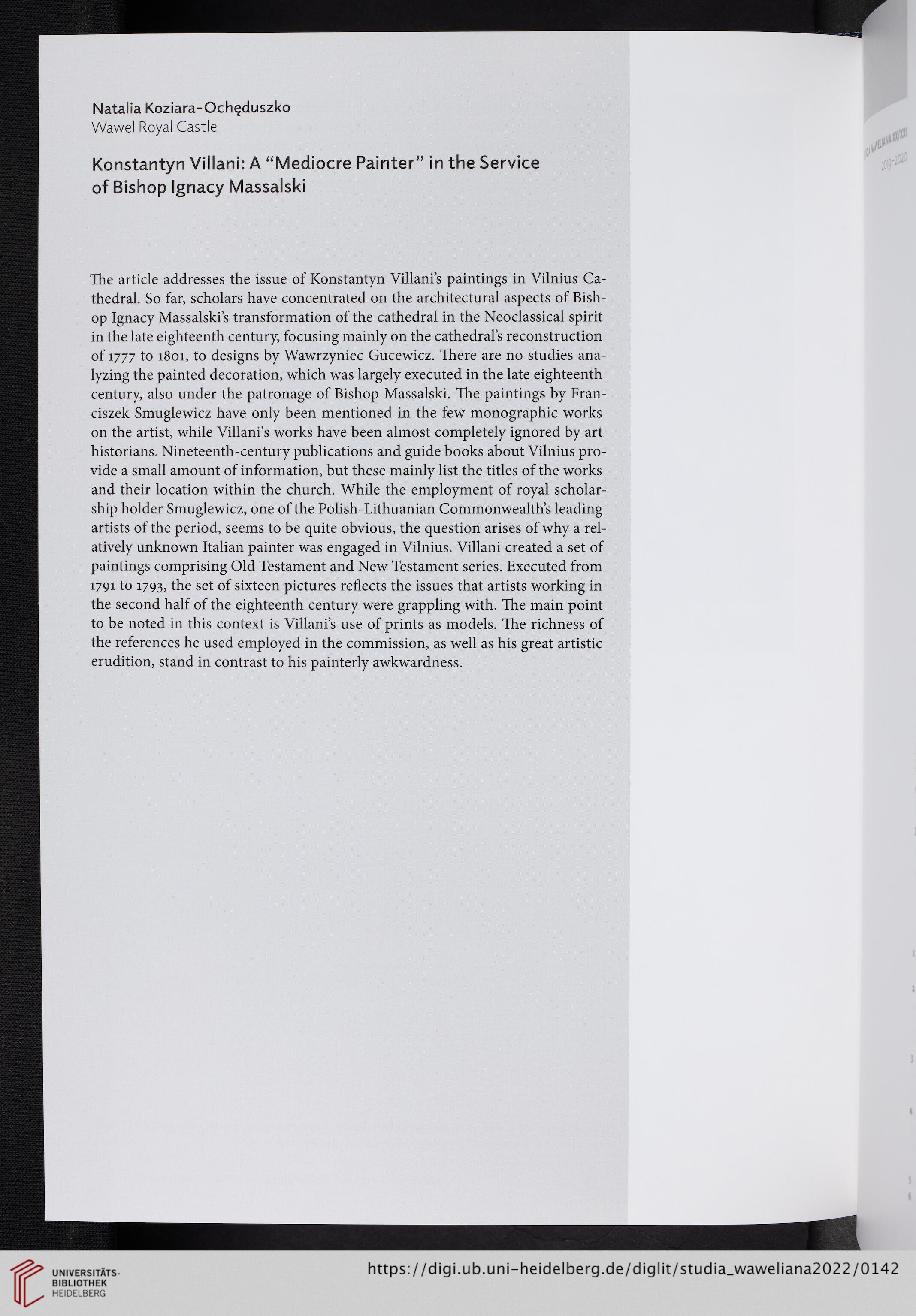Natalia Koziara-Ochęduszko
Wawel Royal Castle
Konstantyn Villani: A “Mediocre Painter” in the Service
of Bishop Ignacy Massalski
The article addresses the issue of Konstantyn Villam s paintings in Vilnius Ca-
thedral. So far, scholars have concentrated on the architectural aspects of Bish-
op Ignacy Massalski s transformation of the cathedral in the Neoclassical spirit
in the late eighteenth century, focusing mainly on the cathedral s reconstruction
of 1777 to 1801, to designs by Wawrzyniec Gucewicz. There are no studies ana-
lyzing the painted decoration, which was largely executed in the late eighteenth
century, also under the patronage of Bishop Massalski. The paintings by Fran-
ciszek Smuglewicz have only been mentioned in the few monographic works
on the artist, while Villani’s works have been almost completely ignored by art
historians. Nineteenth-century publications and guide books about Vilnius pro-
vide a smali amount of Information, but these mainly list the titles of the works
and their location within the church. While the employment of royal scholar-
ship holder Smuglewicz, one of the Polish-Lithuanian Commonwealths leading
artists of the period, seems to be quite obvious, the question arises of why a rel-
atively unknown Italian painter was engaged in Vilnius. Villani created a set of
paintings comprising Old Testament and New Testament series. Executed from
1791 to 1793, the set of sixteen pictures reflects the issues that artists working in
the second half of the eighteenth century were grappling with. The main point
to be noted in this context is Villanis use of prints as models. The richness of
the references he used employed in the commission, as well as his great artistic
erudition, stand in contrast to his painterly awkwardness.
Wawel Royal Castle
Konstantyn Villani: A “Mediocre Painter” in the Service
of Bishop Ignacy Massalski
The article addresses the issue of Konstantyn Villam s paintings in Vilnius Ca-
thedral. So far, scholars have concentrated on the architectural aspects of Bish-
op Ignacy Massalski s transformation of the cathedral in the Neoclassical spirit
in the late eighteenth century, focusing mainly on the cathedral s reconstruction
of 1777 to 1801, to designs by Wawrzyniec Gucewicz. There are no studies ana-
lyzing the painted decoration, which was largely executed in the late eighteenth
century, also under the patronage of Bishop Massalski. The paintings by Fran-
ciszek Smuglewicz have only been mentioned in the few monographic works
on the artist, while Villani’s works have been almost completely ignored by art
historians. Nineteenth-century publications and guide books about Vilnius pro-
vide a smali amount of Information, but these mainly list the titles of the works
and their location within the church. While the employment of royal scholar-
ship holder Smuglewicz, one of the Polish-Lithuanian Commonwealths leading
artists of the period, seems to be quite obvious, the question arises of why a rel-
atively unknown Italian painter was engaged in Vilnius. Villani created a set of
paintings comprising Old Testament and New Testament series. Executed from
1791 to 1793, the set of sixteen pictures reflects the issues that artists working in
the second half of the eighteenth century were grappling with. The main point
to be noted in this context is Villanis use of prints as models. The richness of
the references he used employed in the commission, as well as his great artistic
erudition, stand in contrast to his painterly awkwardness.




